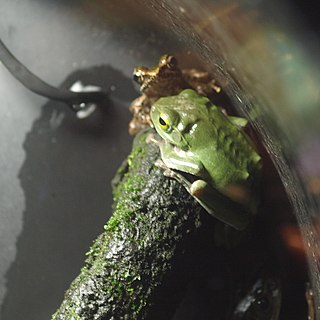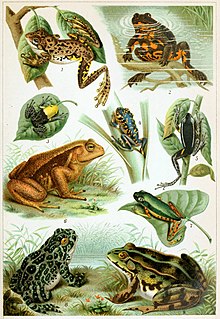Rhacophorus chenfui is a species of frog in the family Rhacophoridae endemic to China where it is found in Sichuan, Guizhou, Hubei, and Fujian provinces. Its natural habitats are temperate forests, subtropical moist lowland forests, subtropical moist montane forests, subtropical moist shrubland, freshwater marshes, rural gardens, ponds, and irrigated land. It is not considered a threatened species by the IUCN.
Rhacophorus dorsoviridis is a species of frog in the family Rhacophoridae that is found in northern Vietnam and southern China (Yunnan). It may be confused with Rhacophorus nigropunctatus. Its natural habitats are subtropical or tropical moist montane forests, freshwater marshes, and intermittent freshwater marshes. It is threatened by habitat loss.

Rhacophorus feae is a species of frog in the family Rhacophoridae. It is found in southwestern Yunnan (China), northern Laos, northern and central highlands of Vietnam, northern Thailand, and Myanmar. The specific name feae honors Leonardo Fea, an Italian explorer, zoologist, and naturalist. Its natural habitats are closed-canopy evergreen rainforests, but it can adapt to human presence. Breeding takes place in streams, ponds, and paddy fields as well as holes in trees; it seems to require large trees. It is threatened by habitat loss and collecting for consumption, at least in the past.

Rhacophorus burmanus is a species of frog in the family Rhacophoridae. It is found in Yunnan in southern China, Nagaland in northeastern India, and northern Myanmar. Its natural habitats are subtropical or tropical seasonally wet or flooded lowland grassland, rivers, freshwater marshes, intermittent freshwater marshes, arable land, rural gardens, ponds, and aquaculture ponds. It is threatened by habitat loss.
Rhacophorus achantharrhena is a species of frog in the family Rhacophoridae endemic to Indonesia. Its natural habitats are subtropical or tropical moist montane forests, rivers, and intermittent freshwater marshes. It is threatened by habitat loss.
Rhacophorus baluensis is a species of frog in the family Rhacophoridae found in northern Sabah and Sarawak in Malaysian Borneo. It is likely to be found in northern Kalimantan. Its natural habitats are submontane and montane forests. Male frogs gather at small ponds. It is potentially threatened by habitat loss caused by logging.
Rhacophorus barisani is a species of frog in the family Rhacophoridae endemic to Indonesia. Its natural habitats are subtropical or tropical moist montane forests, rivers, and freshwater marshes. It is threatened by habitat loss.

Rhacophorus bifasciatus is a species of frog in the family Rhacophoridae endemic to Indonesia. Its natural habitats are subtropical or tropical moist lowland forests, subtropical or tropical moist montane forests, and rivers. It is threatened by habitat loss.
Rhacophorus calcaneus is a species of frog in the family Rhacophoridae. It is endemic to Vietnam. It has been extensively confused with Rhacophorus robertingeri, making it difficult to know its true range. Its natural habitats are evergreen forests at elevations of 1,300–2,000 m (4,300–6,600 ft) above sea level. It is threatened by collection for the international pet trade and by habitat loss and degradation caused by rapidly expanding agriculture, including cash crops such as rubber, coffee and tea.
The jade tree frog, Rhacophorus dulitensis, is a species of frog in the family Rhacophoridae found in Brunei, Indonesia, and Malaysia. Its natural habitats are subtropical or tropical moist lowland forests and intermittent freshwater marshes. It is becoming rare due to habitat loss.

Rhacophorus edentulus is a species of frog in the family Rhacophoridae endemic to Sulawesi, Indonesia. Its natural habitats are rivers, freshwater marshes, and intermittent freshwater marshes.
Rhacophorus georgii is a species of flying frog in the family Rhacophoridae endemic to Sulawesi, Indonesia. Its type locality cannot be located, but it has recently been collected from Buton, off southeastern Sulawesi.
Rhacophorus kajau is a species of frog in the family Rhacophoridae found in Indonesia and Malaysia. Its natural habitats are subtropical or tropical moist lowland forests, rivers, freshwater marshes, and intermittent freshwater marshes. It is threatened by habitat loss.
Rhacophorus modestus is a species of frog in the Rhacophoridae family endemic to Sumatra, Indonesia. Its common name is Boulenger's flying frog. It is only known from the type series collected from a montane forest on the Mount Kerinci, within the Kerinci Seblat National Park. Habitat loss is occurring on the lower slopes of the mountain.

Rhacophorus monticola is a species of frog in the family Rhacophoridae endemic to Sulawesi, Indonesia. Its natural habitats are subtropical or tropical moist montane forests and rivers. It is threatened by habitat loss.
Rhacophorus orlovi is a species of frogs in the family Rhacophoridae. The species is endemic to Southeast Asia.

The harlequin tree frog, Rhacophorus pardalis, is a species of frog in the family Rhacophoridae found in Brunei, Indonesia, Malaysia, Thailand, and the Philippines. Its natural habitats are subtropical or tropical moist lowland forest, subtropical or tropical moist montane forest, freshwater marshes, and intermittent freshwater marshes. It is threatened by habitat loss.
Rhacophorus poecilonotus is a species of frog in the family Rhacophoridae endemic to Indonesia. Its natural habitats are subtropical or tropical moist montane forests and rivers. It is threatened by habitat loss.

Rhacophorus viridis is a species of frog in the family Rhacophoridae. It is endemic to Ryukyu Islands, Japan. It is known from Amamioshima, Kakeromajima, Ukejima, Yoronjima and Tokunoshima islands of the Amami Group, and Okinawajima, Iheyajima and Kumejima islands of the Okinawa Group.
Rhacophorus yinggelingensis is a species of frogs in the family Rhacophoridae endemic to Yinggeling National Nature Reserve, Hainan, China. Its specific name refers to the type locality, Yinggeling, a mountain range in central Hainan.










